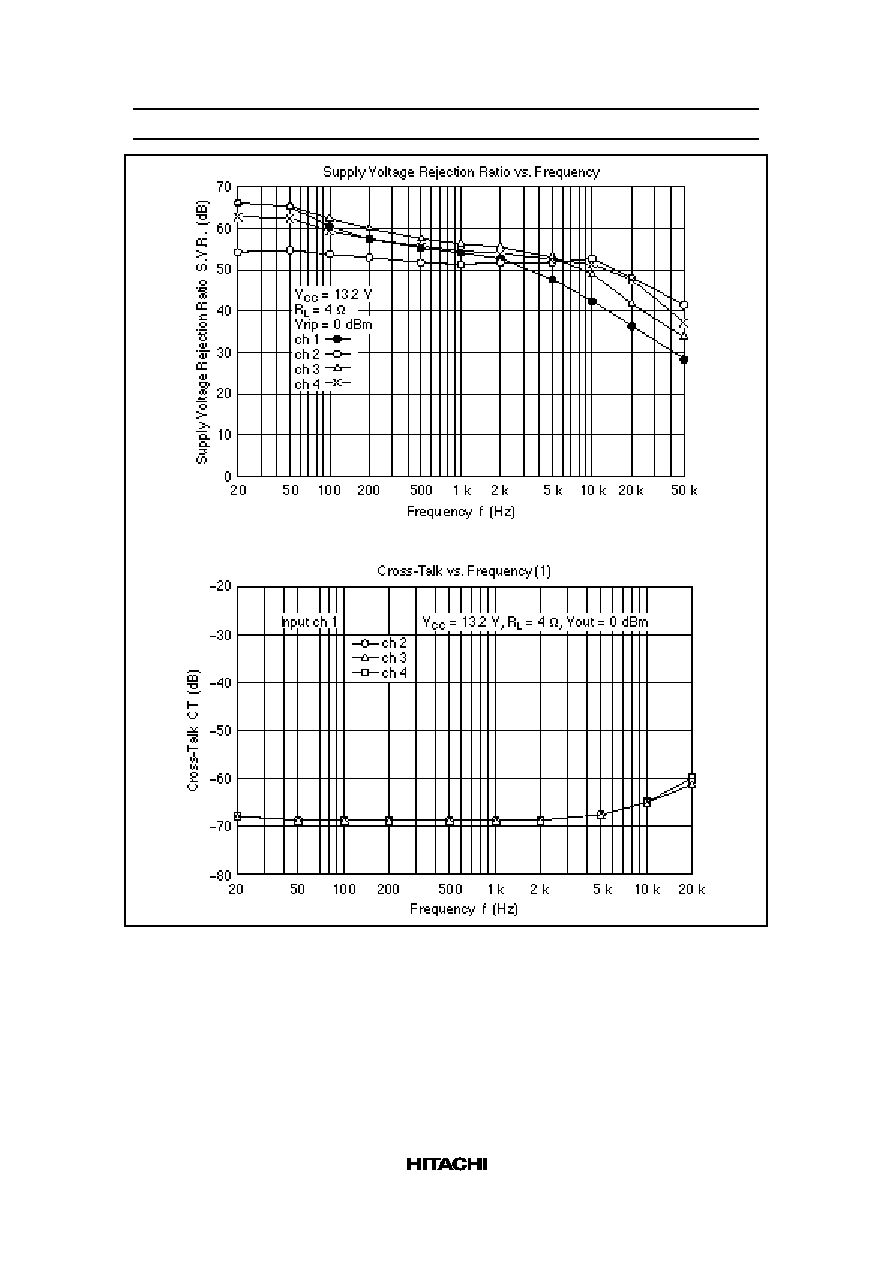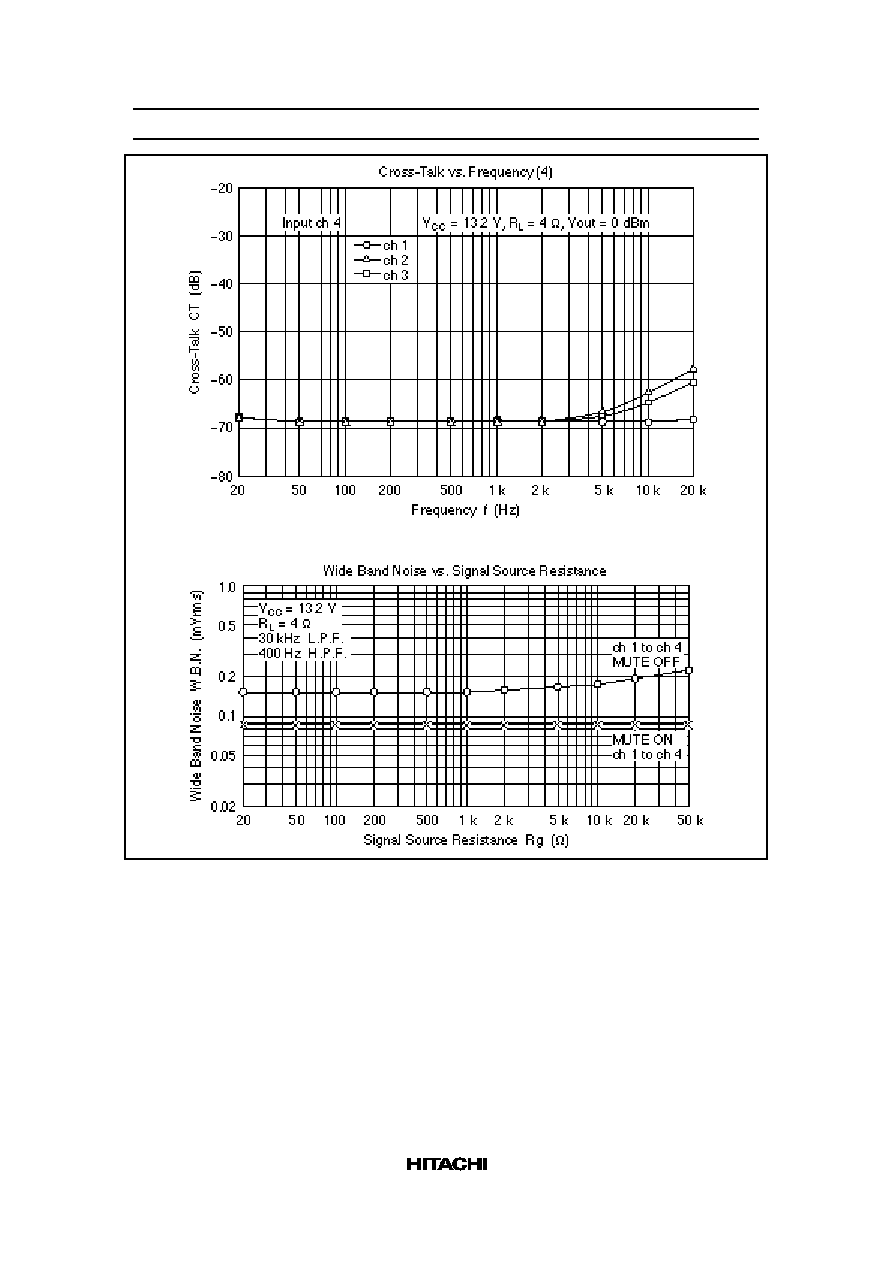 | –≠–ª–µ–∫—Ç—Ä–æ–Ω–Ω—ã–π –∫–æ–º–ø–æ–Ω–µ–Ω—Ç: HA13150 | –°–∫–∞—á–∞—Ç—å:  PDF PDF  ZIP ZIP |

HA13150A
21 W
◊
4-Channel BTL Power IC
ADE-207-107
1st. Edition
Description
HA13150A is a four-channel BTL amplifier IC designed for car audio, featuring high output and low
distortion, and applicable to digital audio equipment. It provides 21 W output per channel, with a 14.4
V power supply and at 10% distortion.
Functions
∑
Built-in standby circuit
∑
Built-in muting circuit
∑
Built-in protection circuits (surge, TSD, and ASO)
Features
∑
Requires few external parts
∑
Low distortion (total harmonic distortion = 0.01% at 3 W)
∑
Low noise (at Rg = 620
, noise is 0.15 mV (muting off) or 0.1 mV (muting on))
∑
Popping noise minimized
∑
Highly reliable current-limiting ASO protector keeps speakers safe from all kinds of trouble.
Reliability is further enhanced by a fast-acting thermal shutdown protection circuit with on/off
hysteresis.

HA13150A
2
Block Diagram
Absolute Maximum Ratings (Ta = 25∞C)
Item
Symbol
Rating
Unit
Remarks

HA13150A
3
Operating supply voltage
V
CC
18
V
Supply voltage when no signal *
1
V
CC
(DC)
26
V
Peak supply voltage *
2
V
CC
(PEAK)
50
V
Output current *
3
I
O
(PEAK)
4
A
Power dissipation *
4
P
T
83
W
Junction temperature
Tj
150
∞C
Operating temperature
Topr
≠30 to +85
∞C
Storage temperature
Tstg
≠55 to +125
∞C
Notes: 1. Tolerance within 30 seconds
2. Tolerance in surge pulse waveform
3. Value per 1 channel
4. Value when attached on the infinite heat sink plate at Ta = 25∞C.
The derating carve is as shown in the graph below.

HA13150A
4
Electrical Characteristics (V
CC
= 13.2 V, f = 1 kHz, R
L
= 4
, Rg = 620
, Ta =
25∞C)
Item
Symbol
Min
Typ
Max
Unit
Test Conditions
Current when no signal
Iq1
--
240
--
mA
Vin = 0
Output offset voltage
Vq
≠250
0
+250
mV
Gain
Gv
30.5
32
33.5
dB
Gain difference between
channels
Gv
≠1.5
0
+1.5
dB
Rated output power
Po
--
18
--
W
V
CC
= 13.2 V
R
L
= 4
, THD = 10%
Max output power
Pomax
--
30
--
V
CC
= 13.7 V
R
L
= 4
, THD = Max
Total harmonic distortion
T.H.D
--
0.01
--
%
Po = 3 W
Output noise voltage
WBN
--
0.15
0.5
mVrms
Rg = 0
BW = 20 to 20 kHz
Ripple rejection
SVR
--
55
--
dB
Rg = 600
f = 120 Hz
Channel crosstalk
C.T
--
70
--
dB
Rg = 600
Vout = 0 dBm
Input impedance
Rin
--
25
--
k
Standby current
Iq2
--
--
200
µA
Standby control voltage
(high)
V
STH
3.5
--
V
CC
V
Standby control voltage
(low)
V
STL
0
--
1.5
V
Muting control voltage
(high)
V
MH
3.5
--
V
CC
V
Muting control voltage
(low)
V
ML
0
--
1.5
V
Muting attenuation
A
TTM
--
70
--
dB
Vout = 0 dBm

HA13150A
5
Pin Explanation
Pin
No.
Symbol
Functions
Input
Impedance
DC
Voltage
Equivalence Circuit
1
IN1
CH1 INPUT
25 k
(Typ)
0 V
11
IN2
CH2 INPUT
13
IN3
CH3 INPUT
23
IN4
CH4 INPUT
2
STBY
Standby control
90 k
(at Trs. cutoff)
--
3
OUT1 (+)
CH1 OUTPUT
--
V
CC
/2
5
OUT1 (≠)
7
OUT2 (+)
CH2 OUTPUT
9
OUT2 (≠)
15
OUT3 (+)
CH3 OUTPUT
17
OUT3 (≠)
19
OUT4 (+)
CH4 OUTPUT
21
OUT4 (≠)
10
MUTE
Muting control
25 k
(Typ)
--

HA13150A
6
Pin Explanation (cont)
Pin
No.
Symbol
Functions
Input
Impedance
DC
Voltage
Equivalence Circuit
22
RIPPLE
Bias stability
--
V
CC
/2
6
PV
CC
1
Power of output stage
--
V
CC
--
18
PV
CC
2
14
INV
CC
Power of input stage
--
V
CC
--
4
CH1 GND
CH1 power GND
--
--
--
8
CH2 GND
CH2 power GND
16
CH3 GND
CH3 power GND
20
CH4 GND
CH4 power GND
12
IN GND
Input signal GND
--
--
--

HA13150A
7
Point of Application Board Design
1. Notes on Application board's pattern design
∑
For increasing stability, the connected line of V
CC
and OUTGND is better to be made wider and
lower impedance.
∑
For increasing stability, it is better to place the capacitor between V
CC
and GND (0.1 µF) close to
IC.
∑
For increasing stability, it is better to place C1 to C8 and R1 to R8, which are for stopping
oscillation, close to IC.
∑
It is better to place the grounding of resistor (Rg), between input line and ground, close to INGND
(Pin 12) because if OUTGND is connected to the line between Rg and INGND, THD will become
worse due to current from OUTGND.
Figure 1 Notes on Application Board's Pattern Design

HA13150A
8
2. How to reduce the popping noise by Muting circuit
At normal operating circuit, Muting circuit operates at high speed under 1 µs.
In case popping noise becomes a problem, it is possible to reduce the popping noise by connecting
capacitor, which determines the switching time constant, between pin 10 and GND. (Following
figure 2)
We recommend value of capacitor greater then 1 µF.
Also transitional popping noise can be reduced sharply by muting before V
CC
and Standby are
ON/OFF.
Figure 2 How to use Muting Circuit
Table 1
Muting ON/OFF Time
C (µF)
ON Time
OFF Time
nothing
under 1 µs
under 1 µs
0.47
2 ms
2 ms
4.7
19 ms
19 ms

HA13150A
9

HA13150A
10

HA13150A
11

HA13150A
12

HA13150A
13

HA13150A
14

HA13150A
15
When using this document, keep the following in mind:
1. This document may, wholly or partially, be subject to change without notice.
2. All rights are reserved: No one is permitted to reproduce or duplicate, in any form, the whole or
part of this document without Hitachi's permission.
3. Hitachi will not be held responsible for any damage to the user that may result from accidents or
any other reasons during operation of the user's unit according to this document.
4. Circuitry and other examples described herein are meant merely to indicate the characteristics and
performance of Hitachi's semiconductor products. Hitachi assumes no responsibility for any
intellectual property claims or other problems that may result from applications based on the
examples described herein.
5. No license is granted by implication or otherwise under any patents or other rights of any third party
or Hitachi, Ltd.
6. MEDICAL APPLICATIONS: Hitachi's products are not authorized for use in MEDICAL
APPLICATIONS without the written consent of the appropriate officer of Hitachi's sales company.
Such use includes, but is not limited to, use in life support systems. Buyers of Hitachi's products
are requested to notify the relevant Hitachi sales offices when planning to use the products in
MEDICAL APPLICATIONS.














